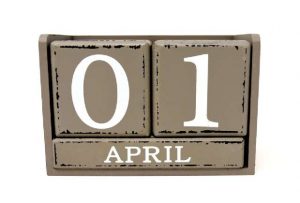The beauty of April 1 is that it offers you the chance to gain some free exposure, highlights the light-hearted side of your business and makes you and your company a talking point for a few days afterwards.
Below, I have listed the key ingredients to help you cook up that perfect Easter dish. This approach is geared towards working with a media partner to maximise coverage. You can, of course, consider running an April Fool online, but this could prove to be a riskier route.
April Fools should end at 12 noon on April 1. So try to include a time reference in your narrative to give the reader/viewers a further clue.

Whats the story?
You are looking for:
- A credible story that COULD be true, but makes people wonder if you are having a laugh
- A narrative that allows you to convey some key messages that will benefit your business. Otherwise, whats the point?
- A relatively simple tale. If you over-complicate it, you will confuse the reader and switch them off
Identify your media partner
While some journalists will stay away from April fools, others are a bit more adventurous.
Once you have decided on your preferred media outlet (TV, radio, local newspaper, national etc), call your contact. If you do not have a relationship, ask for the News Editor. He/she manages news content and should be able to make quick decision.
Make it clear from the start that your story idea is an April Fool. NEVER try to fool journalists it could come back to bite you.
Will they charge me?
No, a journalist will treat this as a news story, so there should be no charge. After all, if they go for it, they are getting a fun story delivered to them on a plate.
Whats the story?
The story needs to be simple. It needs to be credible just but also leave the reader/viewer questioning if it is genuine.
Take a look at news headlines over the last week. Is there a topical subject you could pick up on?
And dont forget, you need to work in a few key messages about your company to ensure you get a good plug out of it.
What could possibly go wrong?
Once you have your story theme, explore all the downsides. What could go wrong? Could it be misinterpreted or is it all very positive?
Remember the person who said there was no such thing as bad publicity should be taken outside and given a firm telling off.
Planning Stage
Allow yourself seven weeks to identify a story concept and then find a media outlet prepared to work with you.
Check that it is a working day of the week. This year (2018) it falls on a Sunday. No local or regional papers publish on a Sunday in Sussex, so your choice of media partner is more limited.
Journalists are busy people, dashing from one deadline to the next. If you are approaching them with an idea, they will probably ask you to email them with a synopsis.
Make this as clear as possible. Journalists are unlikely to have specialist knowledge of your sector, so do not use jargon or technical words or phrases. Keep it simple.

Timings
The story needs to run on April 1 obviously. But you will need to sort out any filming of photography in advance. Be guided by the journalist. They will let you know when they need your input.
Make it exclusive
Once you have found your journalist and sold them the idea, much of your work is done. Your chosen news outlet will assume the story is exclusively theirs, so don’t offer it to other journalists.
Maximising exposure
Once the story has been printed/televised, the exclusivity deal is finished, Other media are unlikely to touch it, but work out in advance what else you can do.
For example, an email to your clients and suppliers, with a link to the story. You can explain how it came about and talk them through the planning stages. Most people have a fascination with journalists.
Post event
Its always sensible to maintain relationships with the media, wherever possible. So thank them for all their guidance and support and start your planning for next April Fools Day. There is no guarantee of a re-run, but if you dont ask you dont get.
Case Study
Some years ago I was asked by Eastbourne Pier to get them regional TV exposure to promote their range of shops and boutiques.
It was at a time when a wealthy US investor had expressed an interest in buying the Eiffel Tower in Paris. Yes, really!
Cobb PR adopted and adapted a similar theme. We began work around a US investor falling in love with the eccentricity of an English pier and deciding he wanted to own one.
We weaved into the story the fact that he loved the shops and boutiques on Eastbourne Pier and so had decided this would be the pier he wanted to buy.
Next, we found an American who was prepared to play along with the idea.
We then contacted Meridian TV and discussed the idea, stressing that it was an April Fool.
The News Editor loved the concept and we started planning. A cameraman filmed the American walking along Eastbourne Pier, talking to shop managers and expressing his love for the pier and the assorted retail outlets.
The TV reporter then interviewed him, when he stated that he was going to put in an offer, although he had a deadline of 12 noon, as that was the time of his flight back to the US.
Meridian loved the finished news item and ran it on the evening news. And to ensure that readers were not fooled for too long, the news reader reminded viewers at the end of the programme that it was April Fools day.
If you need some guidance on crafting the perfect April Fool, we’d love to help. Drop us a line at hello@cobbdigital.com or call the team on 01323 416999.



